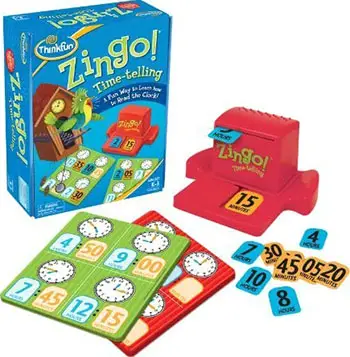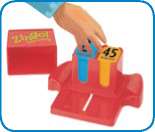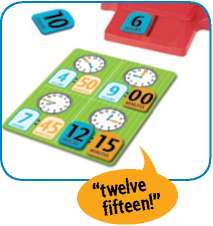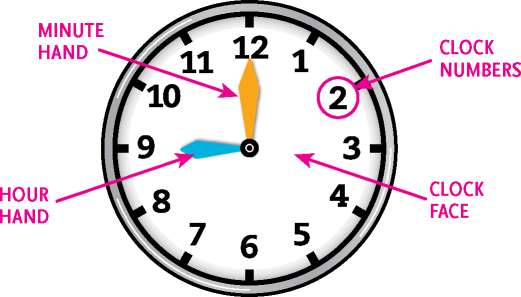
Now you can play your favorite Zingo game and teach time all at once! Zingo! is a fun and interactive game that brings fast-paced excitement and learning to the classic game of Bingo!
In this time-telling version, players will learn to read the hour and minute hands on an analog clock and make the translation to a digital clock. With two levels of play, this is a great way to begin teaching children to tell time and the perfect game for them to grow with!

Components
- 32 Hour Tiles
- 32 Minute Tiles
- 6 Double-sided Zingo! Time-telling Cards
- 1 Zingo! Zinger
- Instructions
Object of the Game
Be the first to cover all the spaces on your Zingo! card with the matching "hour" and "minute" tiles by correctly identifying all four clock times.
Setup
-
Remove the top of the Zingo! Zinger and scramble the 64 tiles.
-

Load the tiles back into the Zinger in two stacks, with the blue "hour" tiles on equal stacks, with the blue "hour" tiles on the left side and the orange "minute" tiles on the right. Replace the top.
-
All players should have a clear view of the Zingo! Zinger before play begins.
-
Each player selects a card. Cards are double-sided to allow for two levels of play. Players should choose which side they would like to play with.
The green side is better for beginners. Both digital and analog time is shown and players need to match the hour and minute tiles.
The red side is for more advanced players. This side only shows the time in analog and players need to read the clock and choose the tiles to correctly show the time digitally.
Note: All players do not have to use the same side.
Game Play
-
Decide whether one player will serve as Dealer and operate the Zingo! Zinger, or whether players will pass the Zinger each turn, giving everyone a chance to operate the device during a game. We recommend choosing an adult or older child to be the first Dealer.
-
The Dealer slides the Zingo! Zinger forward and back to reveal two tiles.

-
When a player sees an "hour" or a "minute" tile that matches one of the spaces on his or her card, that player calls out the number and increment (e.g. six hours or thirty minutes), takes the tile and covers the corresponding space on his or her card.

The Dealer slides any unclaimed tiles back into the Zinger through the slots at the top of the device.
-
If two or more players need the same tile, it goes to the player who calls out the correct number and increment first. In case ofa tie, the Dealer slides the tile back into the Zinger.
-
Whenever a player completes a clock by covering the spaces for BOTH the hour and the minute, he or she must call out the entire time that the clock is showing.

-
If a player calls for a tile that he or she doesn't need, the tile goes to the next player to correctly call it.
-
The first player to cover all 8 spaces on his or her card shouts "Zingo!" and wins the game!
End of the Game
The winner starts the next game as the Dealer.
Game Variations
Minutes or Hours: In this version the first player to correctly match all four blue hour spaces or all four orange minute spaces on his or her card is the winner. Decide whether to play using hours or minutes before the game begins.
Before's and After's: Have players practice calling out 5 after, quarter after, 20 after, and half past when reading the time. For an additional challenge, players can say quarter 'til, 25 before, etc.
Learning Guide
Tips on how to use Zingo Time-telling as a fun learning tool
-
Learn the (lock: Take a moment to introduce new players to the features on a clock; the face, the hour hand, and the minute hand. Talk about what each hand represents and what the hands are pointing to.

-
Read Digital Time: Using the green side of the cards, explain how digital time is read, and how the hands on the clock face correlate to the digital expression of time underneath.
Count by 5's: Focus on the minute hand. Demonstrate counting by 5's, and using the minute hand to determine the correct number of minutes.
Practice by going through each of the clocks on a card, counting by fives to get to the correct number of minutes. As you play, remember that winning the minutes tile is a big deal for little players.
-
Learn About the Hour Hand: Focus on the hour hand.
Explain that this hand will often be between numbers and that this correlates to how many minutes have passed in the given hour. Explain that when looking for the hour, we always look at the number immediately behind the hour hand.
-
Build Memory and Concentration: Encouraging players to study their cards before the game begins will help them to focus on the tiles they are looking for. Pause midway through the game to ask which tiles are still needed.
Frequently reminding players to pay attention to these details will persuade them to think about the goal and concentrate on the task at hand.
-
Practice Good Sportsmanship: Young players are just beginning to move away from parallel play and becoming comfortable playing competitive games. Learning to take turns, have patience and celebrate the success of others takes time and is a great skill to practice while playing Zingol
-
Engage the Whole Family: While Zingo Time-telling! is particularly designed to support the learning needs of young children, the fast-paced gameplay and two levels make this a great game for the whole family.
Level the playing field by tweaking the rules slightly-give older siblings two game boards to fill instead of one or play on teams with kids vs. grown-ups.
-
Have Fun: Sure Zingo! is a great educational game, but first and foremost it's designed to be loads of fun!
Learning to tell time can be tough work so keep the mood light and celebrate when there is a success with a high five or a silly wiggle dance. It's true that laughter helps with learning too!
Continue Reading


